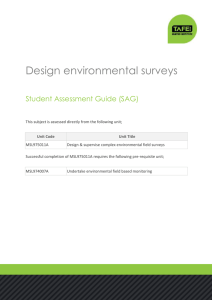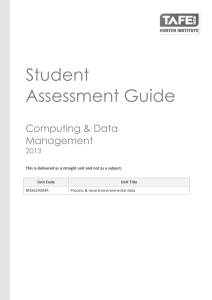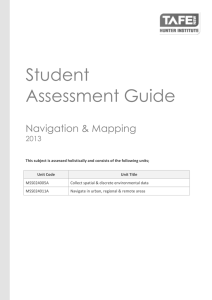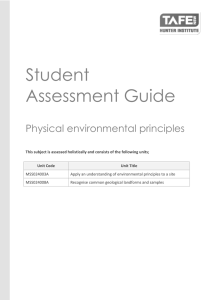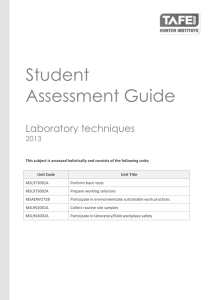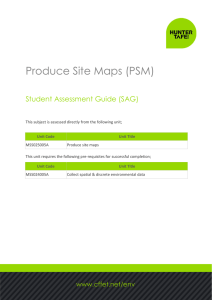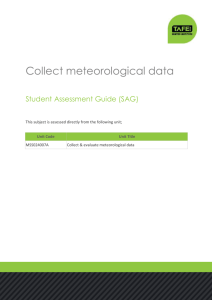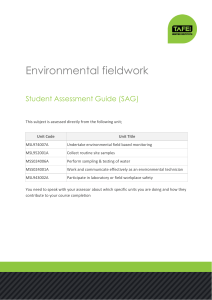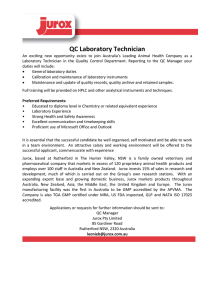Environmental Impact Assessment Student Assessment Guide (SAG)
advertisement
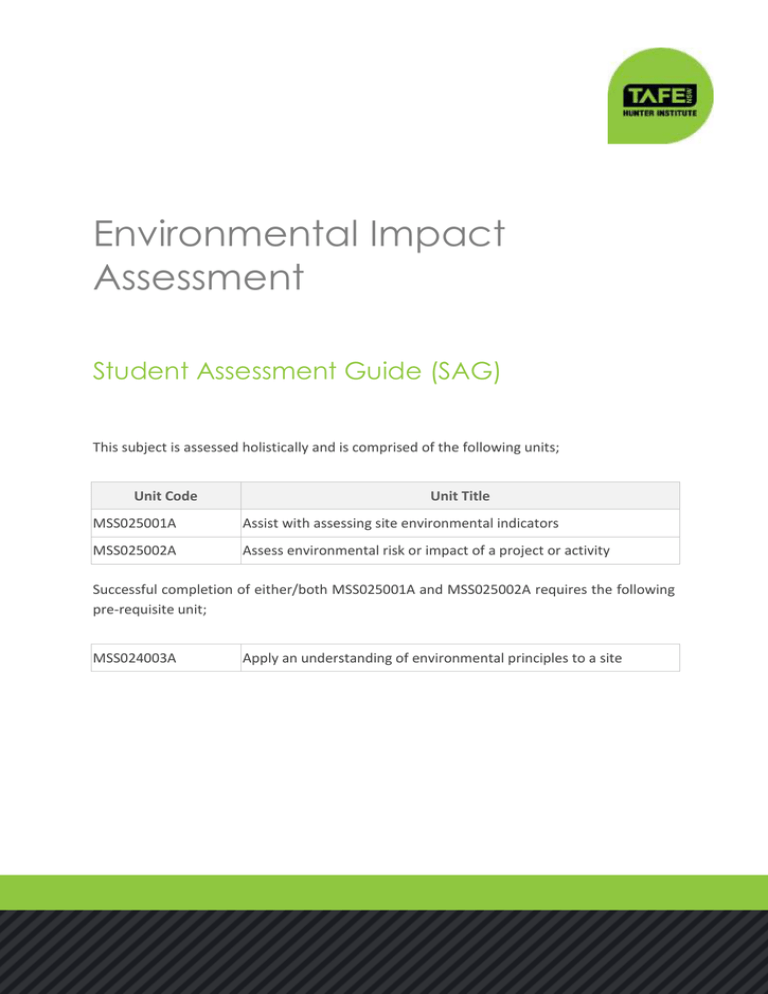
Environmental Impact Assessment Student Assessment Guide (SAG) This subject is assessed holistically and is comprised of the following units; Unit Code Unit Title MSS025001A Assist with assessing site environmental indicators MSS025002A Assess environmental risk or impact of a project or activity Successful completion of either/both MSS025001A and MSS025002A requires the following pre-requisite unit; MSS024003A Apply an understanding of environmental principles to a site Environmental Impact Assessment SAG Subject purpose This subject covers the ability to; assist environmental scientists and engineers with determining the environmental condition of a site or locality, and, evaluate the risks or impacts associated with a specific project activity or process Personnel are required to locate and assess relevant data sets and reports, interpret the magnitudes and trends in measured environmental parameters, and determine and report on the potential significance for site/locality activities. It includes researching and describing the activity/process and local environment, identifying relevant environmental issues, assessing environmental risks or impacts, and then identifying appropriate environmental management actions and/or alternatives. This requires sufficient knowledge of environmental science to interpret measurements involving the atmosphere, biodiversity, land and water. The subject does not cover the collection of field data. Personnel will have access to an enterprise environmental management plan for the site and/or a checklist to guide risk/impact assessment of the activity or process against enterprise, community, and/or legislative requirements. They work under the supervision of environmental managers, scientists, engineers and/or planners Assessment Assessment for this subject will consist of five (5) assignments based on key aspects of assessing site risks and indicators and includes; • Reviewing site history to identify environmental issues of the activity • Determining the risk associated with the activity • Determining relevant environmental indicators to monitor activity • Analyse data to determine the level of impact • Documenting & reporting the impact of the activity on the environment There is substantial assignment work required for this unit. The overall assessment for this unit is summarised in the assessment table below; Chemical, Forensic, Food & Environmental Technology [cffet.net/env] Version 2.0 9/07/2014 Page | 1 Environmental Impact Assessment Assessment Task SAG Weighting Site review summary 15% Environmental risk analysis 25% Environmental indicator determination* 25% Data analysis* 15% Environmental Impact Assessment report 20% TOTAL 100% *Note: These assessments are the same as for MSL025011A – Design & supervise complex environmental field surveys and as such the assignments are fully transferable to this subject to avoid duplication. Subject content This subject deals with a wide variety of topics including the following aspects; • environmental services (e.g. sampling and monitoring of air quality, water, soil and noise) • environmental compliance, auditing and inspection • groundwater and clean water (e.g. catchments, supply and environmental flows) • water treatment, storm and wastewater management • solid and hazardous waste management • management of contaminated sites • site remediation/rehabilitation • geotechnical services and civil engineering • natural resource management • geotechnical services • natural resource management • occupational hygiene monitoring (e.g. air, noise and radiation) • groundwater and clean water (e.g. catchments, supply and environmental flows) • water treatment, storm and wastewater management • solid and hazardous waste management • site remediation/rehabilitation • resource efficiency (e.g. energy, water and waste auditing). Chemical, Forensic, Food & Environmental Technology [cffet.net/env] Version 2.0 9/07/2014 Page | 2 Environmental Impact Assessment SAG Grading The assessment for the units in this subject are both recorded as a Class Mark. All assessment events used to determine your result will be locally set and locally marked. Your results will be reported as DISTINCTION, CREDIT, PASS (AC) or FAIL (NYC). To receive a particular grade you must get at least the mark shown below: Grade Class mark DISTINCTION >=83 CREDIT >=70 PASS (ACHIEVED COMPETENCY) >=50 FAIL (NOT YET COMPETENT) <50 Delivery strategy This subject is assessed directly against the unit’s performance criteria. Elements Performance Criteria Subject Weighting Unit Weighting MSS025001A All All 50 100 MSS025002A All All 50 100 Unit NOTE: The subject weighting MUST add up to 100 for the subject, but the Unit Weighting MAY NOT add up to 100 as each unit is weighted differently in each subject it is used in. Refer to cffet.net/env/assessment for further explanation. What you will need To complete this subject successfully you will need; • The course notes • A portable USB flash / thumb drive. • Access to a computer with internet, email and general office programs • Environmental risk spreadsheet (from website) • General computer skills Chemical, Forensic, Food & Environmental Technology [cffet.net/env] Version 2.0 9/07/2014 Page | 3 Environmental Impact Assessment SAG Where to get help Contact your teacher [www.cffet.net/env/contacts] if you run into any trouble this unit. You would be surprised how flexible we are at accommodating your needs, but communication is key. If you don’t let us know you are having trouble, we may have trouble trying to help you. Resources and references References Note that you are not required to purchase, download or read these references (unless specifically directed to by your teacher). Some of these resources might be available from your teacher or library for free. Bates, G. (2010). Environmental Law in Australia. Australia: LexisNexis-Butterworths. Bratram, J. E. (1996). Water Quality Monitoring - A Practical Guide to the Design and Implementation of Freshwater Quality Studies and Monitoring Programmes. New York?: UNEP/WHO. Burden, F. E. (2002). Environmental Monitoring Handbook. McGraw-Hill Professional. DSEWPC. (2010, October 27). Australia's Biodiversity Conservation Strategy. Retrieved May 27, 2013, from environment.gov.au: http://www.environment.gov.au/biodiversity/strategy/states-territories.html Elliot, M. T. (2009). Environmental Impact Assessment in Australia: Theory and Practice, 5th Ed. Sydney, Australia: Federation Press. Ferrier, R. C. (2010). Handbook of Catchment Management. Oxford: Wiley-Blackwell. Glasson, J. e. (2005). Introduction to Environmental Impact Assessment. New York, USA: Routledge. Grammeno, Gaby (Ed). (2009). Planning Occupational Health and Safety, 8th Ed. Melbourne: McPherson's Printing Group. Jorgensen, S. E. (2005). Handbook of Ecological Indicators for Assessment of Ecosystem Health. Boca Raton: CRC Press. Manahan, S. (2000). Environmental Chemistry. Boca Raton: Lewis Publishers. Manly, B. (2009). Statistics for environmental science and management. Boca Raton: Taylor & Francis Group. Newton, A. (2007). Forest Ecology and Conservation. Oxford: Oxford University Press. Schuenemeyer, J. E. (2011). Statistics for Earth and Environmental Scientists. New Jersey: John Wiley & Sons. StandardsAustralia. (2004). AS/NZS ISO 14001:2004 Environmental Management Systems: Requirements with guidance for use. Australia: Standards Australia. Sutherland, W. (2006). Ecological Census Techniques. 2nd Ed. Cambridge: Cambridge University Press. Thomas, I. (2005). Environmental Management Processes and Practices for Australia. Sydney, Australia: Federation Press. U.S.GeologicalSurvey. (Variously dated). National field manual for the collection of water quality data: U.S. Geological Survey Techniques of Water Resources Investigation, book 9, chaps. A1-A9. available online at http://pubs.water.usgs.gov/twri9A. vanLoon, G. W. (2011). Environmental Chemistry: a global perspective. New York: Oxford Chemical, Forensic, Food & Environmental Technology [cffet.net/env] Version 2.0 9/07/2014 Page | 4 Environmental Impact Assessment SAG University Press. Workplace Health and Safety Act 2011. (n.d.). Workplace Health and Safety Regulation 2011. (n.d.). Resources • TAFE Referencing and plagiarism information can be found here • Information relating to EIA in NSW can be found here • The EPBC Act website can be found here • The NSW office of the EDO can be found here • Not that you need it but free software for statistics can be found here • Another source of NSW DEH EIA information can be found here • Good info on BACI and MBACI can be found here • NSW legislation can be viewed here • The NSW Office of the Greens political party information is here Assessment Submission Students are to submit all assessments by the due date to the subject teacher by email using the following filename format; firstname-surname-assessmentname-duedate Visit cffet.net/env/assessment for more information on submitting assessments, file names and available file extensions that you can use. Chemical, Forensic, Food & Environmental Technology [cffet.net/env] Version 2.0 9/07/2014 Page | 5

